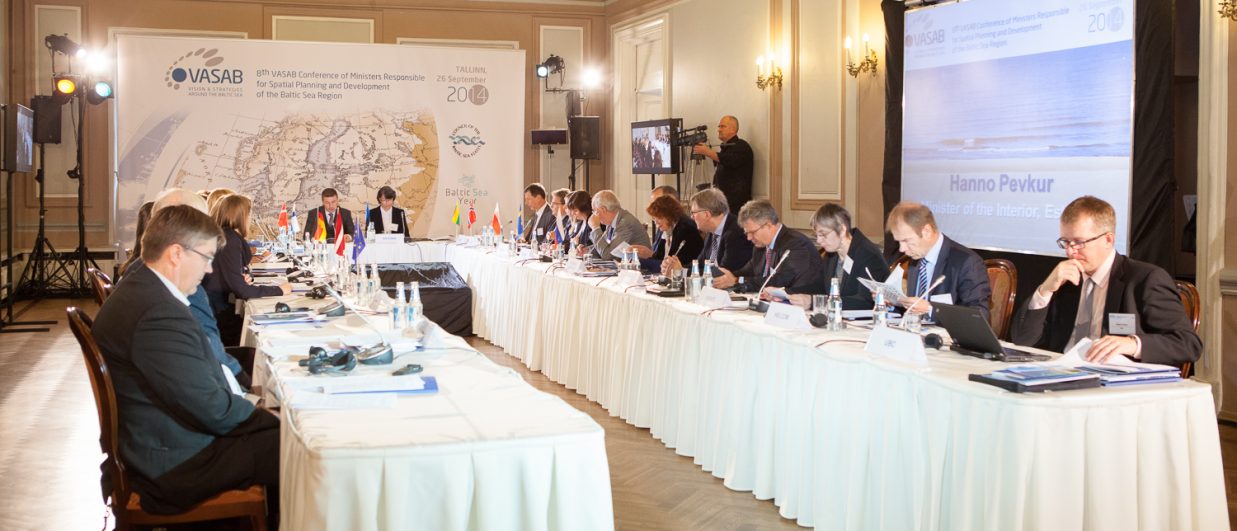History
Political changes at the beginning of 1990’s stimulated the need for long term vision and transnational spatial planning of the Baltic Sea Region. VASAB was founded in August 1992 at the Conference at Ministerial level in Karlskrona, which decided to work out a document “Vision and Strategies for the Baltic Sea Region 2010” and set up a Group of Focal Points from all interested countries and regions to monitor the work on the Final Report.
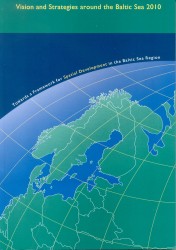 The work started in December 1992 and was successfully completed two years later, when the third Ministerial Conference in Tallinn adopted the Final Report under the title “VASAB 2010. Towards a Framework for Spatial Development in the BSR” (so called “Tallinn Report”) in December 1994.
The work started in December 1992 and was successfully completed two years later, when the third Ministerial Conference in Tallinn adopted the Final Report under the title “VASAB 2010. Towards a Framework for Spatial Development in the BSR” (so called “Tallinn Report”) in December 1994.
It has become not only an outline of spatial development perspective for the Baltic Sea Region and a useful basis for further strengthening and harmonisation of national and regional spatial planning policies, as Ministers wished in their Resolution, but also a handy compendium of very practical guidelines for further common works on projects development.
In it’s resolution the Tallinn Conference also outlined an implementation programme, stressing the role of co-ordination between national and cross-baltic spatial planning, bilateral and multilateral partnerships in projects promotion, intensified exchange of experience, and transfer of know how and spatial research in areas of common interest promotion.
The Conference appointed a Committee on Spatial Development in the BSR (CSD/BSR) with a common interim Secretariat in Sweden to support the CSD in 1995 (the intention of the Conference was that Ministers monitor the ongoing work on annual meetings and next was scheduled for December 1995 in Germany). The CSD was given mandate to co-ordinate the common actions. The Ministers welcomed the intention of the EU Commission to support the implementation of the VASAB action programme, while improving the co-ordination among existing EU Funds and programmes. The CSD was asked to prepare proposals for the continuation of the VASAB 2010 beyond 1996 with special emphasis on future institutional arrangements and co-operation with other regional organisation.
Such a document was prepared and presented to the next, fourth Ministerial Conference convened in Stockholm – Saltsjobadan in October 1996 under German chairmanship, back to back with Environmental Ministers Conference. The Conference gave a very practical framework for all the Vision and Strategies implementation process in the document “From Vision to Action” and it”s “Stockholm Declaration on Sustainable Spatial Development Policy in the BSR”. It also adopted “Common Recommendations for Spatial Planning of the Coastal Zone in the BSR”.
The Conference focused on three dimensions of the future functioning of the Programme:
- sustainability of development and support for drawing up Agenda 21 for the BSR,
- sustainability approach demonstration in number of VASAB projects, many of them enumerated in the Declaration, together with the Common Recommendation for Spatial Planning of the Coastal Zone in the BSR,
- common project implementation under INTERREG II C Initiative, supported by PHARE and TACIS and strict co-operation with INTERREG structures in the BSR.
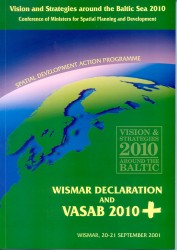 The fifth Ministerial Conference in Wismar (Germany) in September 2001 summed up implementation and set up new goals in VASAB 2010 PLUS Spatial Development Action Programme, calling the CSD/BSR to give more attention to co-operation in the field of spatial development policy at national level.
The fifth Ministerial Conference in Wismar (Germany) in September 2001 summed up implementation and set up new goals in VASAB 2010 PLUS Spatial Development Action Programme, calling the CSD/BSR to give more attention to co-operation in the field of spatial development policy at national level.
VASAB contributed substantially to the process of preparing content side of operational programmes of Baltic INTERREG II C, III B and a concept of INTERREG IV Initiative.
Recognizing new challenges of the Region led by the EU enlargement, the sixth Ministerial Conference in Gdansk in September 2005 instructed VASAB CSD:
- to prepare a long-term perspective for the spatial development of the Region,
- actively influence preparation and implementation of transnational and cross-border territorial cooperation programmes,
- actively take part in the European process of territorial cohesion (Rotterdam-Luxembourg process),
- stimulate and support projects that create model solutions,
- initiate and organise exchange of knowledge on spatial planning and development approaches.
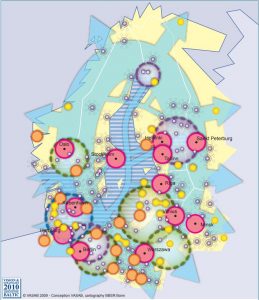 The Long-Term Perspective for the Territorial Development of the Baltic Sea Region (LTP), prepared for the period till 2030 was presented at the seventh Ministerial Conference in Vilnius in October 2009. The LTP identified the most important assets, development trends and challenges affecting the long-term development of the Baltic Sea Region. It predicted the state of the Region in 15- 20 years as a result of joint efforts of countries and organisations; and presented the most important instruments and actions to guide the development of the Region towards territorial cohesion. The document was deliberately profiled to certain policy sectors where the spatial planning cooperation could bring additional value – such as, urban networking and urban-rural relations, accessibility and transnational development zones, sea use planning and integrated coastal zone management. It also recognized a maritime spatial planning as needed tool and process for the Baltic Sea environment and the sustainable use of maritime resources. In this regard the cooperation with HELCOM was initiated. Additionally, Committee on Spatial Development in the BSR (CSD/BSR) was renamed to the ‘Committee on Spatial Planning and Development in the Baltic Sea Region’ (CSPD/BSR).
The Long-Term Perspective for the Territorial Development of the Baltic Sea Region (LTP), prepared for the period till 2030 was presented at the seventh Ministerial Conference in Vilnius in October 2009. The LTP identified the most important assets, development trends and challenges affecting the long-term development of the Baltic Sea Region. It predicted the state of the Region in 15- 20 years as a result of joint efforts of countries and organisations; and presented the most important instruments and actions to guide the development of the Region towards territorial cohesion. The document was deliberately profiled to certain policy sectors where the spatial planning cooperation could bring additional value – such as, urban networking and urban-rural relations, accessibility and transnational development zones, sea use planning and integrated coastal zone management. It also recognized a maritime spatial planning as needed tool and process for the Baltic Sea environment and the sustainable use of maritime resources. In this regard the cooperation with HELCOM was initiated. Additionally, Committee on Spatial Development in the BSR (CSD/BSR) was renamed to the ‘Committee on Spatial Planning and Development in the Baltic Sea Region’ (CSPD/BSR).
The eight Ministerial Conference in Tallinn on 26 September 2014 discussed the progress on implementing the VASAB Long-Term Perspective for the Territorial Development of the Baltic Sea Region. It emphasized territorial development challenges and the need for coherent land and maritime spatial planning, instructed to observe the territorial development processes in the Baltic Sea Region, as well to observe the regional effects of the European transport infrastructure for regional development and territorial cohesion. It also asked for contribution to better adaptation of strategies to different types of areas and propose specific approaches for a diverse urban pattern, as well as underlined the need to apply place-based approaches to development policies at various governance levels.
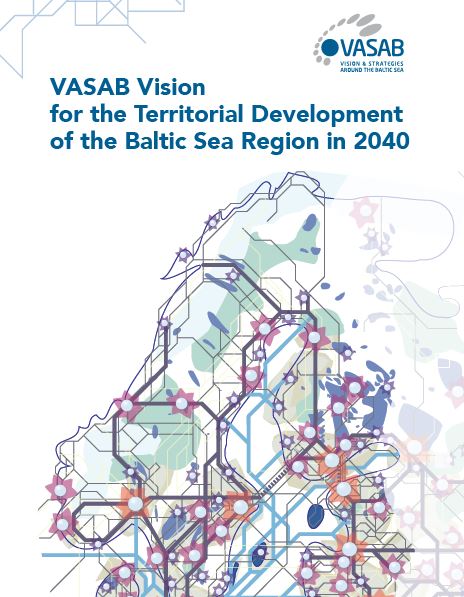 On the 2nd of June 2023, the VASAB Ministers responsible for spatial planning and development in the Baltic Sea Region countries met for the 9th VASAB Ministerial Conference to jointly discuss the complex challenges related to the geopolitical and energy policy changes in the Region and beyond. The main focus was the endorsement of the VASAB Vision 2040 and the adoption of the Wismar Declaration 2023, which underlined the commitment of participating countries to implement the VASAB Vision 2040. The Ministers acknowledged that considerable spatial challenges in the Baltic Sea Region can be tackled only through integrated multi-level cooperation and highlighted the importance of collaboration across various networks, such as the EU Strategy for the Baltic Sea Region in which VASAB has been given a prominent role as the Policy area ‘Spatial Planning’ lead coordinator. In this regard the open and co-creative elaboration process of the VASAB Vision 2040 was acknowledged as a prime example of the successful cooperation to address the challenges facing the Region. With the noticeable appreciation of the valuable work of the VASAB Secretariat, the Ministers affirmed the continuity of the VASAB Secretariat and its location in Riga, Latvia as functionally independent entity until the 31st of December 2029.
On the 2nd of June 2023, the VASAB Ministers responsible for spatial planning and development in the Baltic Sea Region countries met for the 9th VASAB Ministerial Conference to jointly discuss the complex challenges related to the geopolitical and energy policy changes in the Region and beyond. The main focus was the endorsement of the VASAB Vision 2040 and the adoption of the Wismar Declaration 2023, which underlined the commitment of participating countries to implement the VASAB Vision 2040. The Ministers acknowledged that considerable spatial challenges in the Baltic Sea Region can be tackled only through integrated multi-level cooperation and highlighted the importance of collaboration across various networks, such as the EU Strategy for the Baltic Sea Region in which VASAB has been given a prominent role as the Policy area ‘Spatial Planning’ lead coordinator. In this regard the open and co-creative elaboration process of the VASAB Vision 2040 was acknowledged as a prime example of the successful cooperation to address the challenges facing the Region. With the noticeable appreciation of the valuable work of the VASAB Secretariat, the Ministers affirmed the continuity of the VASAB Secretariat and its location in Riga, Latvia as functionally independent entity until the 31st of December 2029.
